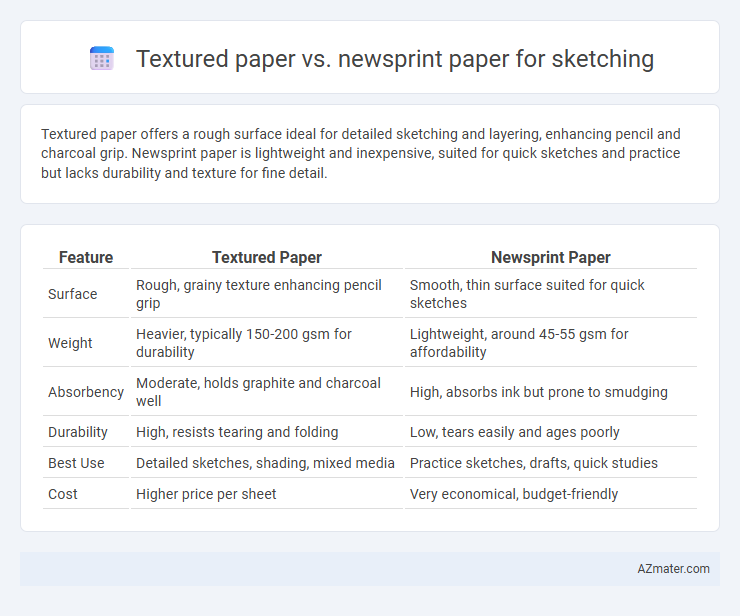Textured paper offers a rough surface ideal for detailed sketching and layering, enhancing pencil and charcoal grip. Newsprint paper is lightweight and inexpensive, suited for quick sketches and practice but lacks durability and texture for fine detail.
Table of Comparison
| Feature | Textured Paper | Newsprint Paper |
|---|---|---|
| Surface | Rough, grainy texture enhancing pencil grip | Smooth, thin surface suited for quick sketches |
| Weight | Heavier, typically 150-200 gsm for durability | Lightweight, around 45-55 gsm for affordability |
| Absorbency | Moderate, holds graphite and charcoal well | High, absorbs ink but prone to smudging |
| Durability | High, resists tearing and folding | Low, tears easily and ages poorly |
| Best Use | Detailed sketches, shading, mixed media | Practice sketches, drafts, quick studies |
| Cost | Higher price per sheet | Very economical, budget-friendly |
Introduction to Sketching Papers
Textured paper offers a rough surface ideal for creating depth and dimension in sketches, enhancing the tactile experience and allowing better grip of dry media like charcoal or pastel. Newsprint paper, being smooth and inexpensive, serves well for quick studies and practice but lacks durability and archival quality for finished artwork. Understanding the properties of textured versus newsprint paper helps artists select the appropriate medium for their sketching needs.
Overview of Textured Paper
Textured paper offers a rough surface with pronounced grain, ideal for adding depth and dimension to sketches by enhancing pencil or charcoal adherence. Its durability and ability to hold multiple layers make it preferred for detailed, expressive artwork compared to the smoother, thinner newsprint suitable mainly for quick studies or practice. Artists favor textured paper for its versatility in creating contrast and texture, essential for refined sketching techniques.
Characteristics of Newsprint Paper
Newsprint paper is lightweight, affordable, and highly absorbent, making it ideal for quick sketches and studies where fast drying is essential. Its smooth surface allows for easy pencil, charcoal, and ink application but lacks durability and archival quality, leading to yellowing and brittleness over time. Newsprint's porous texture absorbs more medium, resulting in softer lines but less precision compared to textured paper designed specifically for detailed artwork.
Texture and Tooth: Key Differences
Textured paper features a pronounced tooth that firmly grips graphite, charcoal, or pastels, enhancing detail and shading in sketching. Newsprint paper has a smoother surface with minimal tooth, making it less ideal for layering but perfect for quick, loose sketches. The tooth in textured paper allows for better medium adherence and blending, whereas newsprint's texture limits its versatility for detailed work.
Durability and Longevity Comparison
Textured paper offers superior durability and longevity compared to newsprint paper for sketching, as its fiber composition resists wear and aging over time. Newsprint paper, made from low-quality pulp, tends to yellow, become brittle, and deteriorate quickly when exposed to light and air. Artists seeking archival-quality sketches favor textured paper due to its robust structure and enhanced resistance to environmental damage.
Paper Weight and Thickness
Textured paper typically has a heavier weight, ranging from 120 to 200 gsm, which provides greater thickness and durability ideal for detailed sketching and layered media. Newsprint paper is much lighter, usually around 35 to 50 gsm, resulting in a thinner sheet that is more prone to tearing and less suitable for heavy use or multiple erasures. The thicker textured paper supports various pencil grades without bleed-through, while newsprint's thinness limits its usability for refined or mixed-media sketches.
Best Media Compatibility
Textured paper offers superior media compatibility for sketching, allowing graphite, charcoal, and pastel to adhere more effectively and produce rich, detailed lines and shading. Newsprint paper, while affordable and lightweight, tends to be less absorbent and prone to smudging, making it suitable primarily for quick studies or practice sketches rather than finalized artwork. Artists seeking durability and versatile media performance generally prefer textured paper for its enhanced surface grip and archival qualities.
Cost and Availability
Textured paper offers superior durability and enhanced grip for sketching, but typically comes at a higher cost and may be less accessible in general art supplies stores. Newsprint paper is widely available and very economical, ideal for practice and preliminary sketches, though it lacks longevity and texture variety. Artists often balance budget constraints with their need for quality by choosing newsprint for everyday sketches and textured paper for finished or detailed work.
Suitability for Beginners vs Professionals
Textured paper offers enhanced tooth and grip, making it ideal for beginners who benefit from added control and detail during sketching. Newsprint paper, with its smooth surface and affordability, suits professionals practicing quick studies or preliminary drafts due to its ease of use and disposability. Beginners gain confidence from textured paper's forgiving nature, while professionals often prefer newsprint for rapid iterations and large-scale work.
Conclusion: Choosing the Right Sketching Paper
Textured paper offers enhanced grip for pencil and charcoal, allowing for richer detail and deeper shading, making it ideal for artists who prioritize texture and layering in their sketches. Newsprint paper, being smooth and lightweight, is better suited for quick studies and practice sketches where cost-efficiency and speed are essential. Choosing the right sketching paper depends on the artist's technique, desired finish, and budget, with textured paper favored for final pieces and newsprint preferred for preliminary work.

Infographic: Textured paper vs Newsprint paper for Sketching
 azmater.com
azmater.com